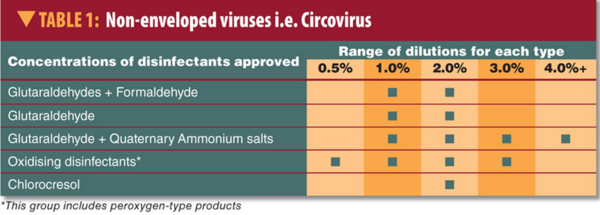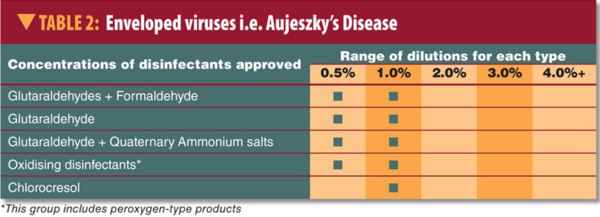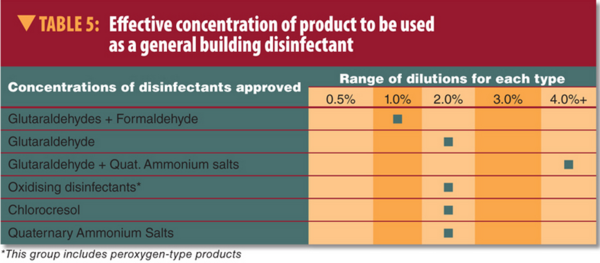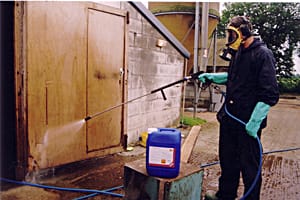.
--> Introduction
--> Choosing the right disinfectant
.
PIG BIO-SECURITY
- Preventing disease with disinfectants -
By Jim Bigmore*
.
INTRODUCTION
The shift in emphasis toward disease prevention across Europe has pushed the use of disinfectants and other bio-security products to the forefront. It has also raised the question of which is the best type of disinfectant to use on a pig farm.
The answer is simple - there is no best one; each product has its own benefits and shortcomings.
^ Top page
.
CHOOSING THE RIGHT DISINFECTANT
When choosing a disinfectant, the trick is to understand the needs of the pig farm and the properties of the disinfectants available. Then find the optimum solution for the individual farm’s situation.
To decide which disinfectant provides the optimum solution, there are three questions which need to be answered:
- Which type of disease organism needs to be controlled – bacteria, viruses (enveloped or non-enveloped), fungi?
- What has to be disinfected – buildings, equipment, water, transport, personnel?
- How can the efficiency of footbaths be improved – coping with extremes in temperature, high organic matter?
Many countries have independent sources of information to help pig farmers with their selection. In Europe, one of the best is provided by the German Veterinary Association’s website www.dvg.de, where a comparison can be made across various disease groups.
Table 1 to Table 6 show the range of dilutions approved by the German Veterinary Association for products of each type of micro-organism.
Table 1: Non-enveloped viruses, i.e. Circovirus
Table 2: Enveloped viruses, i.e. Aujeszky’s Disease
Table 3: Bacteria, i.e. Salmonella
Table 4: Fungi, i.e. Aspergillus
Table 5: Effective concentration of product to be used as a general building disinfectant
Table 6: Suitability of product to be used in various instances / situations
It is interesting to note that these concentrations do not agree with most of the manufacturer’s recommended concentrations. This is probably connected to the manufacturer’s wish to be more cost-effective than the competitors and the recommendations are based on the product’s efficacy when used in ideal conditions.
Please note that the German Veterinary Association tests are conducted at low temperatures and with a high organic matter loading. They therefore represent the worst possible environment in which a disinfectant can be effective.
^ Top page
.
COMPARING DISINFECTANTS
Another problem for pig farmers is comparing products when they are all tested under different conditions. In general, the European tests are more demanding than the equivalent American testing procedures.
From our own experience, if the product is used at the “correct” concentration, for example, as recommended by an independent organization (such as the Department for Environment, Food and Rural Affairs in the UK and the German Veterinary Association) we have never seen resistance build up against a disinfectant.
In a perfect world all disinfectants would kill all bacteria, viruses and fungi on all surfaces without being dangerous to humans, animals, equipment and vehicles. They would be active at all temperatures and not be affected by the presence of organic matter.
You won’t be surprised to hear that this is not the ideal world and no single disinfectant is suitable for every use. The regional variations of climate, farm building materials, animal genetics and management means some cannot be used.
There is, however, one thing that all disinfectants have in common - they won’t work if they don’t come into contact with the germs. In other words, success in disinfection is dependent upon thorough cleaning. Time spent cleaning surfaces for disinfection is never wasted.
^ Top page
.
KEEPING SURFACES CLEAN
Choosing the most appropriate product can be confusing as manufacturers tend to claim that their products work in all situations. At best, some disinfectants are suitable in most applications, providing the correct concentration is used.
Image 1 Even the outside of farm buildings can become contaminated, especially older buildings with absorbent cladding
The overriding rule is to clean first and then to disinfect. A suitable regime would involve the following sequence of events as there are no real shortcuts to ensure the process will be effective:
- Dry-clean - remove organic matter and dirt (mechanically/by hand)
- Wet-clean – apply a suitable detergent (alkaline- or acid-based) to remove the grime without damaging the object.
- Clean down and rinse with water using suitable pressure washer equipment as appropriate.
- The surfaces can be tested at this stage for presence of protein. Re-clean if tests show the surfaces are still dirty.
- Rinse with water
- Dry (if the surfaces are still wet the dilution of the disinfectant will be wrong when it comes in contact)
- Disinfect – preferably dry surfaces to avoid diluting the disinfectant (as above)
- Rinse when necessary, or allow to dry
Remember to check on recommended application rates and exposure times. Disinfectants need time to be in contact with the organisms they are to kill or destroy if they are to work effectively. And never underestimate the importance of a footbath, which is often the frontline of any defense against disease entry or spread of disease from house-to-house within a pig unit.
^ Top page
.
FOOTBATH BIOSECURITY
However, it presents a unique disinfection problem. The disinfectant has to work in an environment where the temperature may change from day to day, the organic matter challenge continually increases and rain can further dilute the disinfectant solution.
It is, therefore, quite likely that a pig farm’s footbath disinfectant is far from ideal. It may either be ineffective because of high organic matter loading, or too dilute because of rain. Alternatively, it may be too concentrated and wasting money!
The modern footbath allows the user to measure the amount of disinfectant and water to produce the recommended concentration. It will have a lid to stop rain diluting the disinfectant solution and will be simple to incorporate into the farm’s standard operating procedure.
Image 2 A footbath is often the front line of protection against transfer of infection on entering a unit or between houses
It will also allow footbaths to be ‘auditable’ by having a removable label that shows the date of footbath was filled, type of disinfectant used, batch number and concentration of the disinfectant used etc.
Understanding the properties of disinfectants can be precursor to thorough disease-prevention protocol on a pig farm or any farm.
^ Top page
.
* Jim Bigmore, Director of Hysolv Ltd, England. www.hysolv.com
This article appeared in Pig International, May/June 2012. ©Copyright 2012, All Rights Reserved.
.
Source: wattagnet.com Updated: Jun 04, 2012.
.
Related topics: producer disinfectant technical information swine biosecurity disinfection

 Corporate Website
Corporate Website
 Africa
Africa
 Argentina
Argentina
 Asia
Asia
 Australia
Australia
 Belgium
Belgium
 Brazil
Brazil
 Bulgaria
Bulgaria
 Canada (EN)
Canada (EN)
 Chile
Chile
 China
China
 Colombia
Colombia
 Denmark
Denmark
 Egypt
Egypt
 France
France
 Germany
Germany
 Greece
Greece
 Hungary
Hungary
 Indonesia
Indonesia
 Italia
Italia
 India
India
 Japan
Japan
 Korea
Korea
 Malaysia
Malaysia
 Mexico
Mexico
 Middle East
Middle East
 Netherlands
Netherlands
 Peru
Peru
 Philippines
Philippines
 Poland
Poland
 Portugal
Portugal
 Romania
Romania
 Russia
Russia
 South Africa
South Africa
 Spain
Spain
 Sweden
Sweden
 Thailand
Thailand
 Tunisia
Tunisia
 Turkey
Turkey
 Ukraine
Ukraine
 United Kingdom
United Kingdom
 USA
USA
 Vietnam
Vietnam











